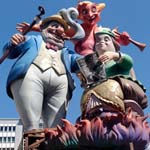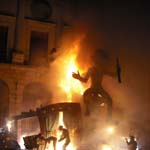Fallas
The Fallas is a popular celebration taking place in Valencia, that's held in commemoration of Saint Joseph, patron saint of the carpenters. The word Fallas derives from the Medieval Latin term fax, which means torch. The association of the word with fire gave this celebration its name. Read on to discover why!
Origin

According to popular tradition, the carpenters of Valencia would have initiated this custom when they burned the leftovers of their work and ateliers in big bonfires on the night before their patron saint, in order to clean up their workspaces before the coming of the spring. Because days grew longer at that time of the year, they also burned the parots -the structures that held the candles to light them while at work-, for they wouldn't be necessary again until the autumn. According to this theory, popular inventiveness would have given a human shape to the parots, creating then the great grandparents of the ninots -the papier-mache figures that are burnt nowadays, built into a bigger structure also called falla-. There is also a pagan version that claims that the Fallas are a natural continuation of the pagan rites in which bonfires were lit to celebrate certain special dates like summer solstice or, like in this case, the spring equinox.
Whether the former or the latter gave way to the modern celebration of the Fallas, the firt historic record dates back to 1740, when burlesque monuments were lit up in the streets of Valencia. These monuments were made out of wood, carton and wax. At the beginning of the XX century, the Fallas were progressively abandoning the political and satirical influence in the sculptures, to focus on the artistic side of the work, which eventually led to the creation of the Fallero Artist position, and the techniques and materials used for the construction of the fallas also evolved. Once the Franco dictatorship was over, the Fallas regained their critical and satirical tone.
Events
Almost every street of Valencia has a meeting place for the falla commissions which receives the name Casal Faller. These associations fund the construction of the fallas throughout the year organizing cultural and social events that also work as social booster for Valencia. Their objective is to build the fallero monuments, which will be burned on La Nit de la Cremá (literally, The Night of the Burning). These monuments usually present a central figure which sums up the theme of the falla and can be up to 30 meters high surrounded by smaller paper mache figures that complete the scene, which is described by a sign with a text explaining the meaning of the collection.
- The Crida: It is the opening speech in which the Fallera Mayor (the highest feminine representant of the Fallas) addresses the casals, grouped at the main square of the city, and receives the keys of the city, a symbolic action that signifies the beginning of the celebration.
- Ninot exhibition: the more than 800 puppets that will be burned are exhibited on the days prior to the feast. During the exhibition, a jury selects one of them to be the ninot indultat (the pardoned ninot), the figure that is saved of the flames because of its originality and craftsmanship.

- The mascletá: It is an event that takes place everyday at 14:00 from March 1st to March 19th. It is basically a firecracker spectacle, in which a really loud volume and intensity is reached, to the joy of the locals, for gunpowder and firecrackers have been common elements in all the celebrations of this region since the Moors introduced them in Spain.
- The Plantá: around the 15th of March, the fallas are set up at the main square of Valencia, so that everybody can see the monuments before they're consumed by the fire.
- The Despertá: every day at 8 in the morning, the falleros go around Valencia playing drum music and lighting firecrackers to wake everyone up. This has created a lot aof controversy in the past years due to the fact that only the 19th is a holiday in town, and many neighbours are disturbed by the noise.
- The Offering: a tradition that was born in the mid-years of the past century, it consists in a flower offering to the Virgin of the Forsaken. More than 100,000 people take part in this event which has spectacular results: a 14 meter high flower blanket around the image of the Virgin.
- Fireworks castles: from the 15th to the 19th of March, a fireworks castle is created in the Valencia night sky. The most impressive of all is the one happening on the night of the 18th, lasting for more than 20 minutes and that receives the name of La Nit del Foc (The night of fire).
- The Fire Parade: as a prelude to the burning of the fallas, there is a parade where the falleros, disguised as devils, bring the fire to the main square, where the monuments will later burn.
- The Nit de la Cremá: the night of the burning, the peak of the celebration, the moment where the fallas are burnt, and that serves as a closure to the celebration.

 The beautiful paper mache scultures that burn every year in the coastal city of Valencia constitute a satirical critique of the social and political issues.
The beautiful paper mache scultures that burn every year in the coastal city of Valencia constitute a satirical critique of the social and political issues. 